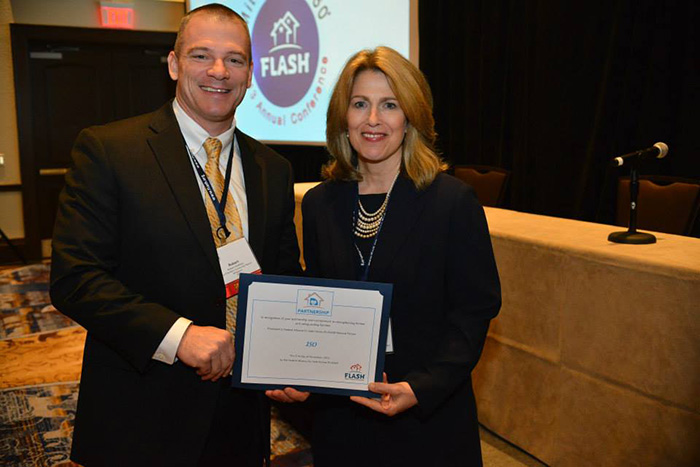Pictured at the symposium are Bob Andrews, vice president, ISO Community Hazard Mitigation, and Leslie Chapman-Henderson, president and CEO of Federal Alliance for Safe Homes (FLASH).
ISO evaluates the effectiveness and enforcement of building codes in more than 21,000 individual communities nationwide representing 87 percent of the U.S. population. We grade them using the Building Code Effectiveness Grading Schedule (BCEGS®). The ISO BCEGS program encourages the most current code adoption and rigorous enforcement efforts. We’ve designed the program to promote catastrophe-resistant buildings, which can reduce property losses and the economic and social disruption that results from catastrophes. We provide the program at no cost to the community or jurisdiction under evaluation.
To reinforce our commitment to building code adoption and enforcement through the BCEGS program, we’ve joined the national nonprofit Federal Alliance for Safe Homes (FLASH®) to encourage communities to build disaster-resistant buildings that can withstand hurricanes, tornadoes, earthquakes, and other catastrophic events.
“Our core belief is that strong, well-enforced codes are the underpinning of a community’s ability to better withstand natural disasters,” said Robert L. Andrews, vice president of ISO Community Hazard Mitigation. “FLASH’s efforts align perfectly with the goal of our BCEGS classification system, and we look forward to working with them to improve building codes and construction. Alarmingly, some of the most vulnerable parts of the country are underprotected due to poor enforcement efforts or outdated code editions.”
FLASH is the country’s leading consumer advocate for strengthening homes and safeguarding families from natural and man-made disasters. The organization collaborates with more than 100 innovative and diverse partners that share its vision of making America a more disaster-resilient nation.
“We’re excited to work with a leading organization such as ISO to spread the word about disaster safety and empower individuals, families, and communities to invest in strong, safe, and sustainable homes,” said FLASH President and CEO Leslie Chapman-Henderson. “Joining forces with the most influential and talented minds to promote best building and enforcement practices is essential to making America more disaster-resilient.”
In Oklahoma, more than 95 percent of all tornadoes have a National Weather Service rating of EF1 or EF2, producing maximum wind speeds of 135 miles per hour. An ISO analysis revealed that in virtually the entire region commonly known as Tornado Alley, current construction standards are for wind speeds only up to 90 miles per hour. In contrast, communities in many Atlantic Coast states build to withstand 135 mile-per-hour wind speeds, establishing improved standards to help save lives and minimize property damage.


